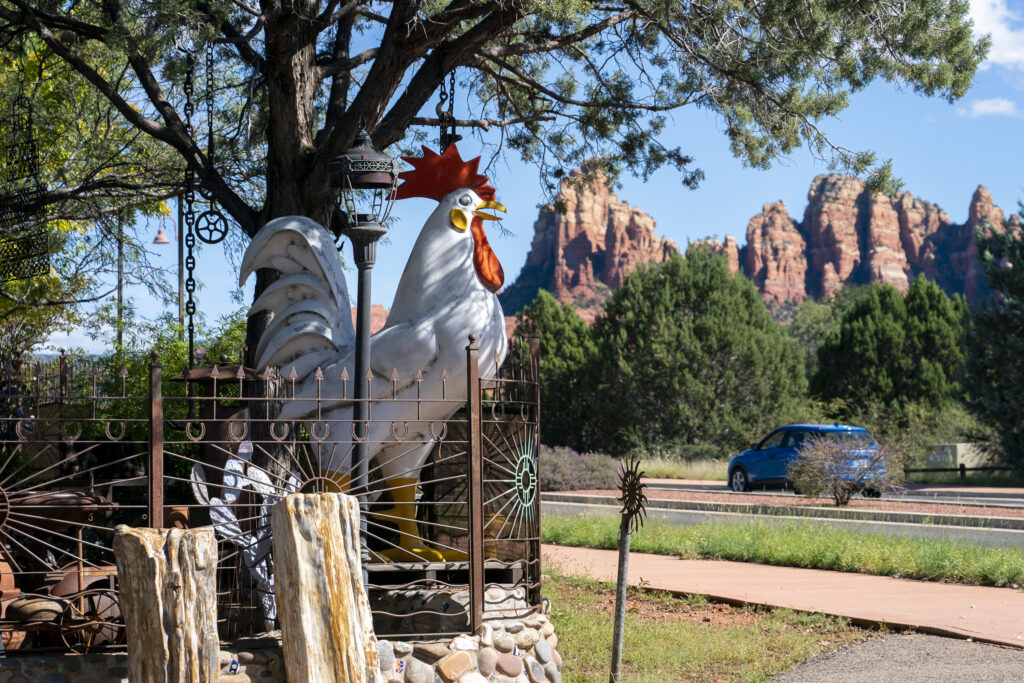Nearly six and a half years after Sedona City Attorney Robert Pickels expressed the hope that the Sedona Board of Adjustment’s long-running case against the Son Silver West Gallery could be resolved in “a couple of weeks,” the city and the gallery have agreed to a final settlement.
Son Silver West was founded as an in-home art gallery in the Broken Arrow subdivision in 1960. Four years later, Coconino County rezoned the subdivision as residential, but allowed the gallery to continue operating since it predated the rezoning. The gallery acquired its current name in 1981 when it was purchased by the Robson family.
In 1987, the Robsons purchased a second lot adjoining their original property, which they used to expand the gallery. The newly-incorporated city of Sedona subsequently issued SSW a notice of violation for using the adjacent lot for commercial purposes.
According to city policy, when a nonconforming use occupies a building, expanding that use into additional buildings or land areas is prohibited. Nevertheless, after negotiations with the city, the Robsons obtained a conditional use permit for the lot in 1992. In 1994, Sedona adopted a new land development code that precluded further revisions to the conditional permit.
Between 1992 and 2014, the Robsons acquired three more neighboring lots, none of which were covered by their conditional use permit. One of these became a parking lot for SSW cus tome r s . Anothe r contained a shed that the Robsons converted to the “Father Kino Chapel” where they sold religious memorabilia.
In 2014, Sedona’s director of community development issued the Robsons notices of violation for those parcels not covered by the CUP. After SSW made and then withdrew an application to have the additional lots rezoned, the city issued new notices on all five properties.
The Robsons appealed these violations in turn to the Board of Adjustment, the Coconino County Superior Court and the Arizona Court of Appeals, all of which largely upheld the city’s position. Following continued noncompliance by SSW, the city applied for a permanent injunction against the company in 2019.
The Robsons argued that their use of the additional lots for commercial purposes was legal on the basis of a 2011 correspondence with then- Community Development Director John O’Brien, which they claimed tacitly recognized their existing operations as being compatible with their permit. O’Brien stated in a 2016 affidavit that he did not have the authority to modify the permit, nor did he attempt to do so.
“The city of Sedona is still trying to shut down our business, although on file we have certified documents, that the city has and we have, saying that we have legal, grandfathered rights, explicit written and verbal permission, to be the way we are,” Rio Robson said in 2017.
Robson also claimed that city officials would stop and photograph the property three times a week “to keep trying to intimidate us” and that a city employee visited the gallery to photograph him on the employee’s day off. “The only reason he was out there taking photos of us was because we are guilty of being busy. It’s unbelievable … hurting family businesses is not the answer.”
The Robsons actively courted public support, including from City Coun-cilman John Currivan, a long-time customer of Son Silver West. Currivan called their situation “a special case” and argued before the council in 2017 in favor of the city rezoning the parcel SSW was using as a parking lot. Currivan also pushed for Son Silver West’s application to be fast-tracked to the front of the Planning & Zoning Commission’s queue.
That same year, Sedona accountant Jessica Presti estimated that the city had spent over $1 million so far on legal action against SSW.

Under the terms of the settlement, Son Silver West has agreed to limit its enclosed retail s pace to 4,900 square feet and its outdoor retail spce to 5,564 square feet, with an additional 620 square feet of storage space and 1,271 square feet of workshop space.
SSW will allow city staff entry at any time during business hours for inspections, discontinue use of the vacant lot for parking, screen the lots and maintain dark-sky compliant outdoor lighting, and erect a fence between the Robsons’ commercial and residential properties. The Robsons may retain the Father Kino Chapel but may use it only for personal religious purposes.
In exchange, the city will dismiss its ongoing request for an injunction against SSW and issue the Robsons a business license.
While these terms represent a substantial reduction from the 5,000 and 16,000 square feet of indoor and outdoor retail space, respectively, that SSW occupied at its greatest extent, they are also a significant increase over the limits specified in the 1992 permit.
The original permit allotted SSW 3,550 square feet for retail space and a pottery shop, 5,000 square feet of outdoor retail space, 590 square feet of storage space, and 750 square feet of workshop space. Although the 2017 superior court judgment ordered SSW to restore its business areas to the size originally approved in the 1992 permit, the settlement effectively bypasses both the judgment and the city’s land use code to allow SSW to expand its facilities by 25 percent.
On the advice of city staff, the Sedona City Council approved the settlement unanimously on Sept. 27 with no further discussion.
“It is deemed in the best interest of the city of Sedona and its citizens that the city enter into [this] Settlement Agreement … to memorialize compliance with CUP 92-3,” the council’s resolution read.
CUP-923-Documents-All